Artworks at Villa Umi
Since Prehistoric times when Humans started to draw animals on walls of the caves they were living in, art has been a way for us to cope with the hardship of our existence, along with philosophy which appeared much later.
From China

Sword with its scabbard, Yunnan Province, 19th century
Imported from the island of Borneo (Indonesia) where Chinese people were travelling for trade. The close-up photo shows ancient Chinese writings on the sword.

Opium box, Ink on ivory
This artwork, with a delicate drawing of a young lady on one side and of a landscape on the other, was used as a small opium container. In ancient times, Chinese people used to inhale opium. They used a small spatula (see close-up photo) to take opium from the small box, usually while they were comfortably lying down in locations dedicated to this social activity.
From Korea

Vase, Ceramic
Historically, Chinese art had a great influence on Korean ceramics and art, on Persian ceramics, and on Japanese art.
From Japan

Hokusai, Reproduction of The Great Wave
In the 19th century, Japanese painter Hokusai created a technique called “Ukiyo-e” which had a great influence on impressionist painters like Monet, Manet, Renoir, and Van Gogh.
Around the same time, Japanese painters Hiroshige and Eisen also had a great influence on Van Gogh and Monet who painted women in kimonos.
Several books on these artists are on display in the library of Villa Umi.
From India

Painting, Ink on ivory
Two pieces of ivory are glued together to form a canvas. The artist drew a delicate scene in which the influence of Persian miniatures clearly appears.

Marble plate engraved with semi-precious stones
Made by local craftsmen who are still replicating the works of ancient craftsmen who built the Taj Mahal in the 17th century, a grandiose mausoleum made out of white marble engraved with semi-precious stones. The Taj Mahal was dedicated by Shah Jahan, a Mughal Emperor, to his beloved wife Mumtaz Mahal, daughter of a wealthy Persian noble. Mumtaz passed away a short time before the start of the construction of the Taj Mahal.

Wooden window, Jaisalmer
Jaisalmer is an old city located in the middle of the Thar desert, in the State of Rajasthan (literally meaning "land of kings") in the North West of India, near the Pakistan border.
Such small windows were used in houses traditionally built with ornately carved sandstone.
Jaisalmer also has beautiful Jain temples, while Ranakpur, another city in Rajasthan, has a marvellous Jain temple made out of ornately carved white marble.
Jainism is a religion which praises life in all its forms. It prohibits the destruction of any form of life, even the life of microbes, leading the most avid devotees to renounce taking antibiotics.

Sculpture, Sandalwood
From Cambodia

Sculpture, Jade and wood
In Hindu and Buddhist mythology, Apsara is the female spirit of the clouds and waters. This sculpture depicts a sensual dance, referring to Hinduism which led to the construction of Angkor Wat, the largest Hindu temple in the world, located in the city of Siem Reap in Cambodia.
Siem Reap means "Thailand defeated" referring to a failed attempt by fighters from Thailand to invade Cambodia a long time ago, as they were stopped in Siem Reap.
Angkor Wat is drawing visitors from around the world, including India. In ancient times, Indians were travelling to various countries for trade, including Cambodia. At the same time, they propagated their faith in Hinduism which praised sexuality as a gift from Mother Nature. Sexuality was considered as a necessity for a happy life, as it appears from numerous ancient erotic sculptures still visible in Khajuraho, India.

Elephant, leather
From Myanmar (Burma)

Handmade embroideries
These artworks were purchased in Myanmar one year before the military coup of 2021.
In Myanmar, Buddhist extremist leaders, do not tolerate Rohingya people on their land. Rohingyas are Muslim people who fled Bangladesh a long time ago. Some Burmese people worry that a growing influence of Islam might lead to restrictions on individual freedom, particularly for women, like in Iran and Afghanistan.
From Indonesia

Silver sculpture, Bali
In ancient times, such houses were used by large groups living under the same roof. In Bali nowadays, it is common to see compounds with a temple in the middle surrounded by several buildings in which various members of a given family live. One such compound is surrounded by a high wall providing privacy.
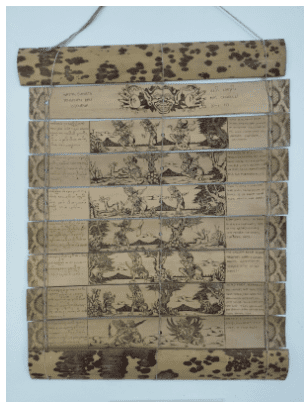
Ink on bamboo, Bali, 1993
Mythological poems are drawn like a cartoon, annotated on the left side in Balinese and on the right side in English.

Masks, Bali
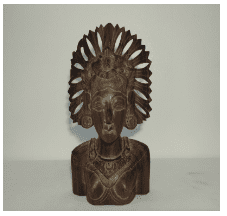

Sculpture, Bali
This intricate sculpture was carved from a single piece of wood.
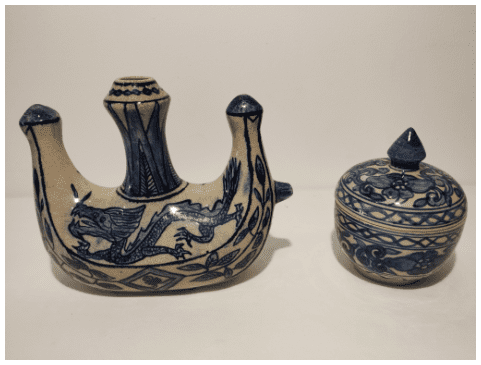
Ceramic Vases, Borneo
From The Philippines

Seashell artwork, Bohol

Seashells
“The Philippines in the 19th Century”, a book about Filipino art history, is on display in the library of Villa Umi.
From Malaysia

Traditional moon kite
Called “Wau Bulan”, this kite is a symbol of Malaysia and resembles a rising crescent moon when flown. It is reproduced in Malay denomination, as guests may see in a booklet of foreign denominations on display in the library of Villa Umi.
From Russia

Dolls, Painting on wood
Matryoshka dolls are a set of wooden figures of decreasing size, which open in the middle to be placed one inside another.
From Iran

Miniature paintings
These artworks influenced artists in the Northern part of India, which was invaded a long time ago by Persian Emperors.

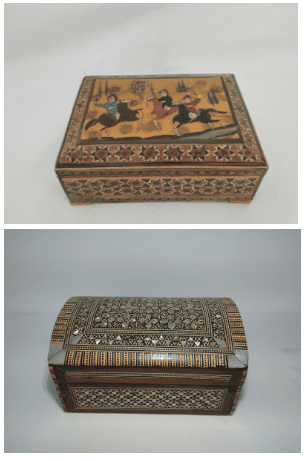
Wooden boxes, Mother of Pearl
In the Middle East, before the apparition of Islam in the 7th century, Zoroastrianism was based on the adoration of fire. Between the 8th and 10th centuries, Islamization led to the emigration of some Zoroastrians, known as "Parsi", to Mumbai in India. They were well integrated into Indian society. A prominent Parsi named Tata has built a giant business empire, still active nowadays. To the contrary, Buddhists in the Middle East didn’t have such an opportunity.
It is of interest to note that Persian art, which began a long time ago under the rule of Islamic religion, displayed people drinking wine and dancing, while some Muslim countries nowadays prohibit such activities.
Many originals of such artworks from Iran are on permanent display at the Louvre Museum in Paris, France.
To learn more about Persian arts, the book “Arts of Persia” is on display in the library of Villa Umi.

Tribute Bearers

Vase and glasses
The blue color symbolizes heaven’s sky, prepared with metal oxide powders mixed with special oils and solvents to form a creamy paint.
From Uzbekistan
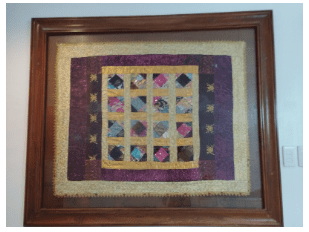
Silk Weaving
Silk is the jewel of Uzbekistan’s handicrafts sector. Weavers dye the threads before weaving them, then use narrow handlooms and the ikat technique to produce fabrics with a distinctive zigzag pattern. These silks are fashioned into dramatic outfits and unique homeware.
From Turkey
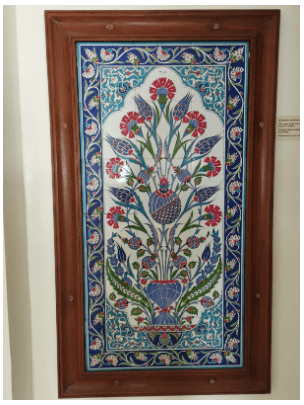
Handmade painting on ceramic tiles
The origins of the art of Turkish tiles can be traced to the 8th century. Turkish tulips symbolize love, civilization and knowledge, and pomegranates are venerated in various religions. Tulips were exported to the Netherlands from Turkey before they became a symbol for the Netherlands, overshadowing the fact that tulips originated not in the Netherlands but in Turkey.
From Egypt
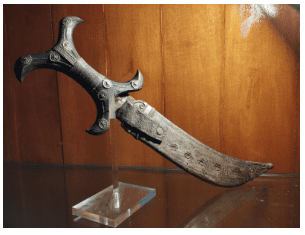
Antique knife with its scabbard, Nubia (Southern part of Egypt near the Sudanese border)
The first monotheism in history preceded Christianity, Judaism and Islam. It was the adoration of the Sun, the only God praised by Egyptian Pharaoh Akhenaten around 1355 before Christ. Although polytheism was widespread at that time in Egypt, Akhenaten prohibited polytheism and imposed monotheism. Soon after his death, polytheism was been restored.
From France
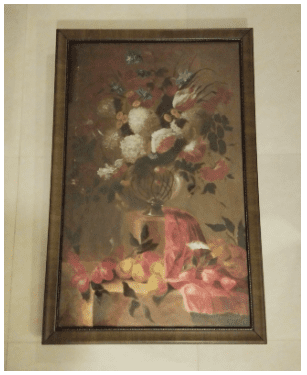
Oil on canvas by Villa Umi owner, after Spanish Master Juan de Arellano, 17th century
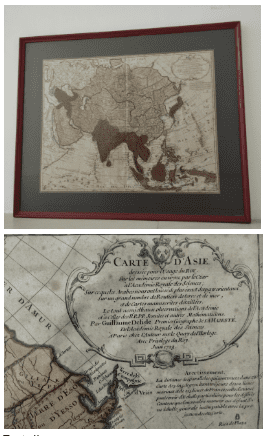
Ancient map of Asia
This map was hand drawn in 1723 for the King of France. One can read "Bohol" in the South of the Philippines. At that time, spices imported from Asia were more expensive than gold. Under the French King Louis XIV, chocolate was a luxury considered as a medicine and consumed by high society.
The French text in the close-up photo translates as follows :
"Map of Asia made for the usage of the King
upon reports sent by the Tsar to the Royal Academy of Sciences :
On what the Arabs let us to know at the best of their knowledge about Eastern countries.
On a large number of land and sea travellers, and detailed handwritten maps.
All of the above subjected to the observations by the Academy and the R.R.P.P. Jesuits and other Mathematicians.
By Guillaume Delisle, First Geographer of His Majesty.
From the Royal Academy of Sciences.
In Paris, at the author’s home at the Quay de l’Horloge
With Privilege from the King.
June 1723"
Beside artworks, Villa Umi also displays two articles from an original French newspaper dated 1911
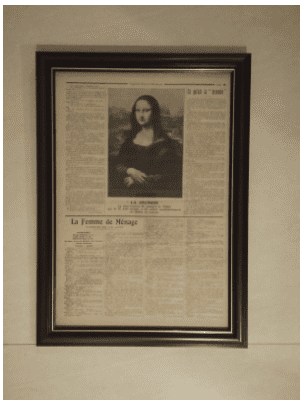
The robbery of the Mona Lisa
In 1911, the Mona Lisa painting was robbed and later given back mysteriously by the robber. Leonardo Da Vinci was invited to France by King François I and travelled from Italy to France across the Alps on a mule and on foot, carrying with him, among other things, his Mona Lisa. The King gave Da Vinci a place to live in Amboise, an area well known for its sumptuous ancient castles, and where Da Vinci died. This is why the Mona Lisa is now exhibited in the Louvre museum in France.
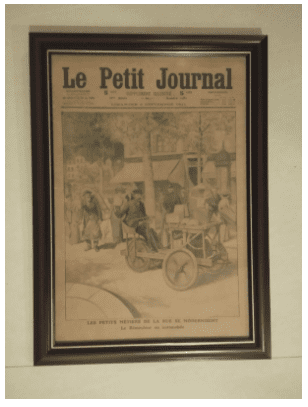
Traditional workers on the street in Paris, 1911
Two jobs are displayed : a craftsman sharpening knives and another one carrying glasses on his back. From his childhood in the 1950s, the owner of Villa Umi remembers craftsmen coming into the courtyard of his apartment complex shouting “vitrier, vitrier” which means “glass installer, glass installer”, offering their services for replacing broken glass windows. These jobs, like many others, don’t exist anymore.
Similarly, Pierre-Auguste Renoir used to work in the traditional world of porcelain painting, until the industrial revolution took over and made the young Renoir lose his job as a craftsman in 1858. He then turned to painting decorations in cafes, before starting a career making oil paintings on canvas.
From Italy
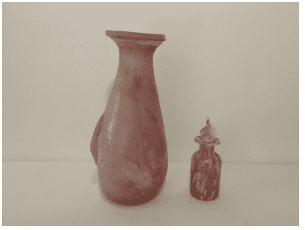
Vase and perfume bottle, Murano
Glass and mirror makers from the small island of Murano near Venice, have the reputation of being the best in the world. Indeed, Murano has a long and rich history. During the reign of the French King Louis XIV in the 17th century, Venice was an independent Republic. While divulging secrets of fabrication was punishable by death, Jean-Baptiste Colbert, appointed by King Louis XIV, managed to send spies to Murano and obtain the secrets. This enabled King Louis XIV to get very tall mirrors made in France and installed into his famous Hall of Mirrors in the palace of Versailles, still visible nowadays.
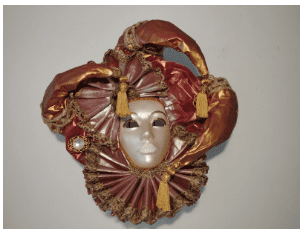
Mask, Venice
This is a unique handmade mask made out of papier-mache, plaster and embroidery. These masks are used during the Venice Carnival in February of each year.
From Greece
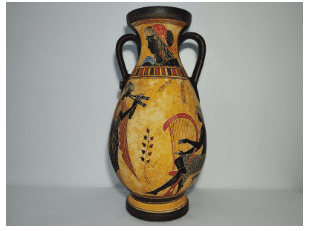
Vase, Clay
This artwork is a modern copy of ancient Greek art. Ancient Greece, with philosophers like Plato, Socrates and Aristotle, is considered as the root of Western civilization. What is less known is that long before, ancient Egyptian philosophy had influenced ancient Greek philosophy.
From Canada
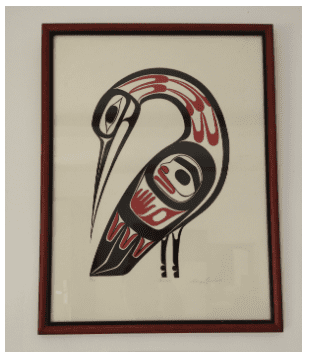
Indigenous drawing, British Columbia
Indigenous people were occupying lands in Canada long before the French and the British colonized them. Indigenous people of North and South America came from Asia, walking on a very long distance through what is now the Bering Strait, which was then a walkable land before the sea took over and separated the North Eastern part of Asia from the North Western part of North America.
From Mexico
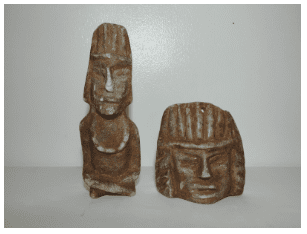
Stone sculptures, Oaxaca

Wooden sculpture, Oaxaca
From The Bahamas
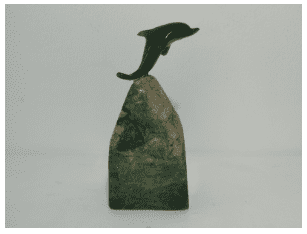
Sculpture, Jade on stone
In the Bahamas, dolphins were kept in semi-liberty in an enclosed area that was opened from time to time, allowing them to leave into the deep sea. The dolphins were free to return from the deep sea into the enclosed area to be fed by their human guardians.
Similarly in Lila (Bohol, Philippines), people can swim with whale sharks. These largest fish in the world are called “gentle giants”. Whale sharks come to the shore from the deep sea every morning to be fed by local fishermen, before returning into the deep sea.
Some criticize the activity of feeding these animals. To the contrary, others argue that it prevents fishermen from killing them, since they now constitute a source of income, which is a compelling incentive to keep them alive and in good health. Around the world, various models of coexistence between endangered species and Humans have been experimented. These issues are for everyone to make their own minds.
From South America
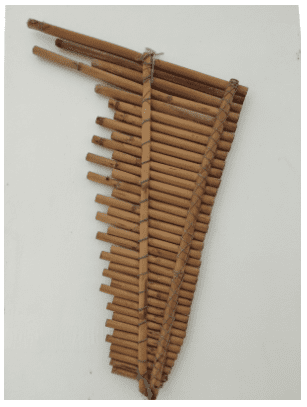
Pan flute, Bamboo
Discover more artworks at Villa Umi Panglao Resort.
We'd love to hear your feedback
At Villa Umi, your feedback is invaluable to us as we continuously strive to enhance our services and offerings. We genuinely care about your experience and want to ensure that every aspect of your interaction with us exceeds your expectations. Your feedback is essential in helping us achieve this goal.

